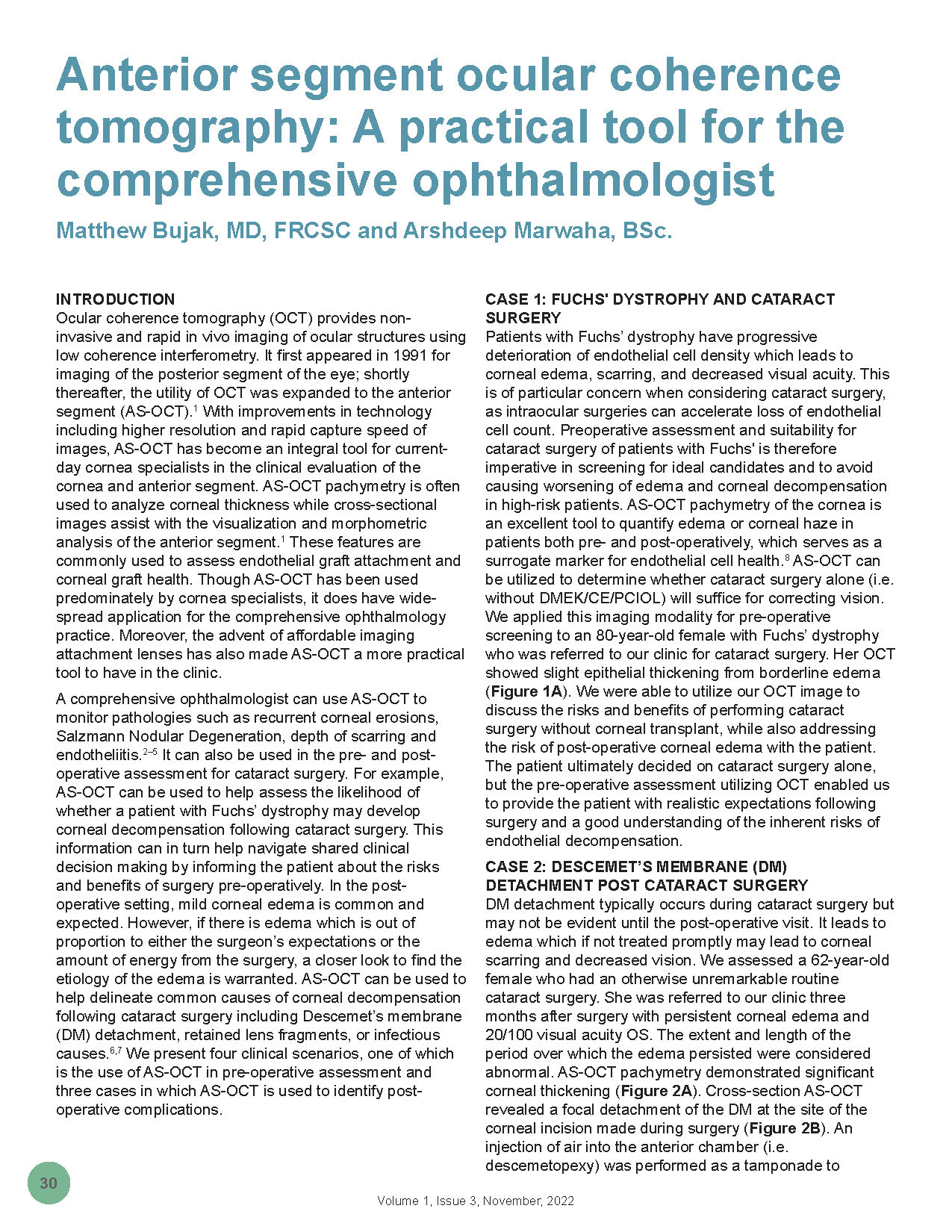Anterior segment ocular coherence tomography
A practical tool for the comprehensive ophthalmologist
DOI:
https://doi.org/10.58931/cect.2022.1319Abstract
Ocular coherence tomography (OCT) provides non-invasive and rapid in vivo imaging of ocular structures using low coherence interferometry. It first appeared in 1991 for imaging of the posterior segment of the eye; shortly thereafter, the utility of OCT was expanded to the anterior segment (AS-OCT). With improvements in technology including higher resolution and rapid capture speed of images, AS-OCT has become an integral tool for current-day cornea specialists in the clinical evaluation of the cornea and anterior segment. AS-OCT pachymetry is often used to analyze corneal thickness while cross-sectional images assist with the visualization and morphometric analysis of the anterior segment. These features are commonly used to assess endothelial graft attachment and corneal graft health. Though AS-OCT has been used predominately by cornea specialists, it does have wide-spread application for the comprehensive ophthalmology practice. Moreover, the advent of affordable imaging attachment lenses has also made AS-OCT a more practical tool to have in the clinic.
A comprehensive ophthalmologist can use AS-OCT to monitor pathologies such as recurrent corneal erosions, Salzmann Nodular Degeneration, depth of scarring and endotheliitis. It can also be used in the pre- and post-operative assessment for cataract surgery. For example, AS-OCT can be used to help assess the likelihood of whether a patient with Fuchs’ dystrophy may develop corneal decompensation following cataract surgery. This information can in turn help navigate shared clinical decision making by informing the patient about the risks and benefits of surgery pre-operatively. In the post-operative setting, mild corneal edema is common and expected. However, if there is edema which is out of proportion to either the surgeon’s expectations or the amount of energy from the surgery, a closer look to find the etiology of the edema is warranted. AS-OCT can be used to help delineate common causes of corneal decompensation following cataract surgery including Descemet’s membrane (DM) detachment, retained lens fragments, or infectious causes. We present four clinical scenarios, one of which is the use of AS-OCT in pre-operative assessment and three cases in which AS-OCT is used to identify post-operative complications.
References
Ang M, Baskaran M, Werkmeister RM, Chua J, Schmidl D, Aranha dos Santos V, et al. Anterior segment optical coherence tomography. Prog Retin Eye Res 2018;66:132–56. doi:10.1016/j.preteyeres.2018.04.002 DOI: https://doi.org/10.1016/j.preteyeres.2018.04.002
VanderBeek BL, Silverman RH, Starr CE. Bilateral Salzmann-like nodular corneal degeneration after laser in situ keratomileusis imaged with anterior segment optical coherence tomography and high-frequency ultrasound biomicroscopy. J Cataract Refract Surg 2009;35:785–7. doi:10.1016/j.jcrs.2008.09.033 DOI: https://doi.org/10.1016/j.jcrs.2008.09.033
Patel NN, Teng CC, Sperber LTD, Dodick JM. New-Onset Herpes Simplex Virus Keratitis After Cataract Surgery. Cornea. 2009 Jan;28(1):108-10. doi:10.1097/ICO.0b013e318182262c DOI: https://doi.org/10.1097/ICO.0b013e318182262c
Zheng KK, Cai J, Rong SS, Peng K, Xia H, Jin C, et al. Longitudinal Evaluation of Wound Healing after Penetrating Corneal Injury: Anterior Segment Optical Coherence Tomography Study. Curr Eye Res 2017;42:982–6. doi:10.1080/02713683.2016.1274038 DOI: https://doi.org/10.1080/02713683.2016.1274038
Kobayashi R, Hashida N, Soma T, Koh S, Miki A, Usui S, et al. Clinical Findings of Anterior Segment Spectral Domain Optical Coherence Tomography Images in Cytomegalovirus Corneal Endotheliitis. Cornea. 2017 Apr;36(4):411-414. doi:10.1097/ICO.0000000000001103 DOI: https://doi.org/10.1097/ICO.0000000000001103
Sayegh RR, Pineda R. Practical applications of anterior segment optical coherence tomography imaging following corneal surgery. Semin Ophthalmol. 2012;27:125-32. doi:10.3109/08820538.2012.707274 DOI: https://doi.org/10.3109/08820538.2012.707274
Soliman W, Fathalla AM, El-Sebaity DM, Al-Hussaini AK. Spectral domain anterior segment optical coherence tomography in microbial keratitis. Graefe’s Archive for Clinical and Experimental Ophthalmology. 2013;251:549–53. doi:10.1007/s00417-012-2086-5 DOI: https://doi.org/10.1007/s00417-012-2086-5
Tao A, Chen Z, Shao Y, Wang JY, Lu P, Lu F. Phacoemulsification induced transient swelling of corneal Descemet’s Endothelium Complex imaged with ultra-high resolution optical coherence tomography. PLoS One. 2013 Nov 28;8(11):e80986. doi:10.1371/journal.pone.0080986 DOI: https://doi.org/10.1371/journal.pone.0080986

Published
How to Cite
Issue
Section
License
Copyright (c) 2022 Canadian Eye Care Today

This work is licensed under a Creative Commons Attribution-NonCommercial-NoDerivatives 4.0 International License.
